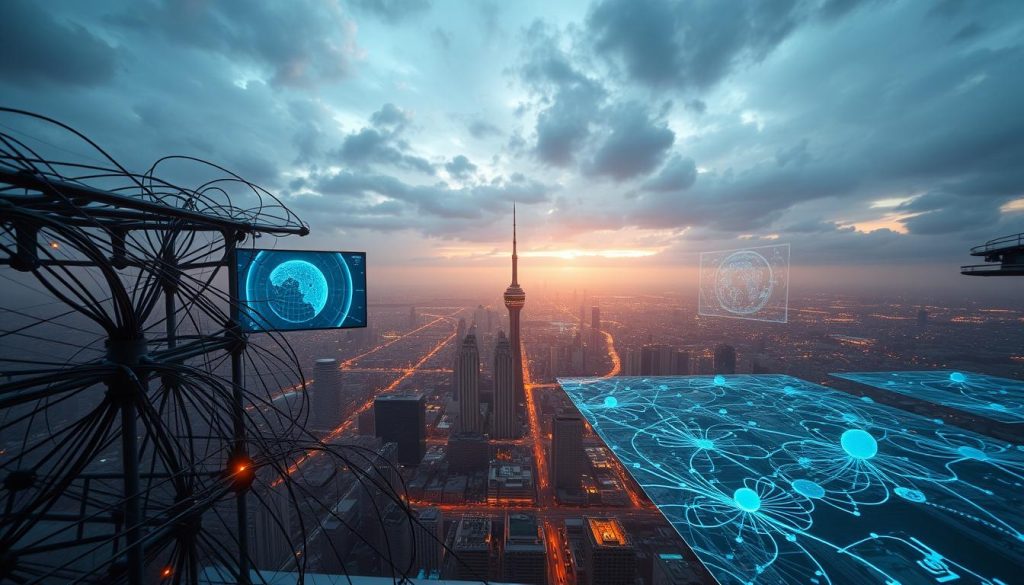Google DeepMind’s latest innovation transforms how we receive weather information. This advanced model processes vast amounts of meteorological data at incredible speeds.
It generates hundreds of potential weather scenarios in under sixty seconds. Such rapid predictions offer unprecedented accuracy for daily planning.
This system represents a significant leap forward in forecasting capabilities. Users gain access to high-resolution predictions through familiar platforms.
Key Takeaways
- An advanced weather model developed by Google’s research teams
- Produces hundreds of forecast scenarios in under one minute
- Delivers highly accurate, high-resolution global predictions
- Integrated into popular services like Search and Maps
- Provides data through the Earth Engine and BigQuery platforms
- Offers practical, reliable forecasting for everyday use
- Early access available via Vertex AI for developers
An Introduction to WeatherNext 2
Access to reliable weather information transforms how we approach our daily routines and activities. This advanced system represents a breakthrough in meteorological prediction capabilities.
WeatherNext 2 is Google’s sophisticated artificial intelligence model, engineered explicitly for probabilistic weather forecasting. It moves beyond traditional single-outcome predictions to generate multiple coherent scenarios.
Developed through collaboration between Google DeepMind and Google Research teams, this technology has transitioned from laboratory development to practical, real-world applications. The system’s architecture represents years of dedicated meteorological research.
At its core, the model processes individual weather variables, such as temperature, wind speed, and humidity. It learns to forecast complex systems by analysing how these elements interact over time.
This approach generates hundreds of possible weather outcomes from a single input dataset. Each scenario accounts for natural uncertainty in atmospheric conditions.
Efficiency represents a key advantage of this system. Traditional physics-based models require hours on supercomputers, while this solution delivers comprehensive forecasts in under sixty seconds using a single TPU.
Performance improvements are substantial compared to earlier versions. The current iteration demonstrates superior accuracy across 99.9% of measured variables and prediction timeframes.
Technical innovation includes noise injection within the function space. This technique creates realistic variability in predictions while maintaining meteorological coherence.
The system supports detailed temporal resolution with hourly forecasts available. It can project conditions up to fifteen days ahead with remarkable precision.
This advancement aligns with broader trends where artificial intelligence enhances weather forecasting for both personal and industrial applications. The technology’s implementation across Google’s ecosystem, as detailed in their official announcement, demonstrates its practical value.
Meteorological prediction has reached a significant turning point with these developments. The integration of advanced computational techniques with atmospheric science creates new possibilities for weather-dependent decision making.
Key Features and Technological Advancements
Modern weather prediction systems now operate at speeds previously unimaginable in meteorological science. These innovations represent significant progress beyond traditional forecasting methods.
Unprecedented Speed and Probabilistic Forecasting
This advanced system generates comprehensive weather forecasts in under sixty seconds. Traditional physics-based models require several hours on supercomputers for similar computations.
Probabilistic forecasting produces hundreds of potential atmospheric scenarios from single input data. Each outcome maintains meteorological coherence while accounting for natural variability.
Processing efficiency enables predictions 8 times faster than previous iterations. According to technical analysis, this speed revolutionises how forecasts are generated and consumed.
The Functional Generative Network Architecture
Functional Generative Network architecture represents the core innovation driving these advancements. It incorporates noise injection directly within function space rather than data space.

This technique ensures physically realistic variability across all generated predictions. The system maintains atmospheric consistency while producing diverse possible outcomes.
Training initially focuses on individual meteorological variables, such as temperature and wind patterns. These marginals then combine to forecast complex emergent systems, including storm fronts.
Superior Accuracy Across Variables and Lead Times
Performance metrics demonstrate remarkable improvements across all measured parameters. The system surpasses previous models on 99.9% of tested variables and prediction timeframes.
Continuous Ranked Probability Score measurements confirm enhanced reliability. Forecasts maintain accuracy across lead times extending up to 15 days.
The temporal resolution is set to hourly increments for precise decision-making. This granularity supports applications requiring detailed timing information.
| Measurement Metric | Previous System | Current Performance |
|---|---|---|
| Processing Time | Several hours | Under one minute |
| Scenario Generation | Single outcome | Hundreds of variants |
| Maximum Lead Time | 10 days | 15 days |
| Temporal Resolution | 3-hour increments | 1-hour increments |
| Variable Accuracy | 94.7% coverage | 99.9% coverage |
Practical applications include predicting regional heatwaves with improved precision. The energy sector benefits from accurate wind farm output forecasts days in advance.
Tensor Processing Units enable this scalable computational performance. Frequent model updates ensure continuously refined predictions as new data becomes available.
The AI That Actually Helps: Google’s WeatherNext 2
Real-World Integration and Applications
Beyond technical specifications, this system’s actual value emerges through practical implementation across various platforms and industries. Its integration transforms how people and businesses interact with meteorological information on a daily basis.
Powering Google’s Ecosystem: Search, Maps, and Pixel
Google’s products now feature enhanced weather displays powered by this advanced forecasting technology. Users encounter more reliable predictions directly within Search results and Gemini interactions.
Pixel devices benefit from sophisticated pixel weather applications that provide hyper-local updates. These improvements offer personalised alerts based on precise location data.
Never miss a turn again: Discover how AI is revolutionising lane guidance in Google Maps.

The Google Maps platform incorporates upgraded weather functionality through its API. Soon, this integration will expand to mainstream Maps applications for broader public access.
This seamless incorporation means millions now receive superior weather forecast information without having to seek specialised sources. The technology works quietly behind familiar interfaces.
Enterprise Access via Google Cloud and Data Platforms
Businesses leverage this system through Google Cloud’s comprehensive data services. Earth Engine provides geospatial analysis capabilities for environmental monitoring.
BigQuery enables large-scale meteorological data querying for research institutions and corporations. These platforms handle immense datasets that would overwhelm traditional systems.
Vertex AI offers early access for custom modelling and inference work. Organisations can tailor forecasts to specific operational requirements through this programme.
“This represents a fundamental shift in how enterprises approach weather-dependent decision making”
The cloud-based architecture ensures scalable access across different industry sectors. Companies pay only for the computational resources they actually use.
Implications Across Industries
Energy & Utilities
Accurate forecasts help energy companies optimise production, anticipate demand spikes, and manage renewable energy sources like wind and solar power more effectively.
Agriculture
Farmers can leverage high-resolution forecasts to plan planting schedules, protect crops from extreme weather, and maximise yield while reducing resource waste.
Logistics & Transportation
Transport companies can plan routes around adverse weather, reduce delays, and improve safety for drivers, passengers, and cargo.
Emergency Services
Probabilistic weather predictions enable governments and disaster response teams to prepare for extreme events, such as storms or heatwaves, with a higher level of confidence.
Conclusion: The AI That Actually Helps: Google’s WeatherNext 2
Why WeatherNext 2 Represents a Forecasting Revolution
Meteorological science has reached a pivotal moment with these advanced models. They offer speed and precision once considered impossible.
These systems generate hundreds of potential forecasts in seconds. This probabilistic approach transforms decision-making across industries.
Functional Generative Network architecture enables realistic predictions. It accounts for variables such as humidity and wind patterns effectively.
Integration across platforms makes sophisticated forecasting accessible globally. Enterprises benefit through custom modelling tools.
Ongoing research continues to enhance this revolutionary model. It empowers better preparedness for climate challenges.


